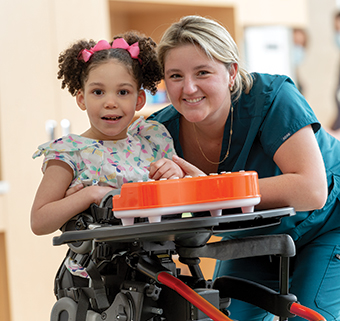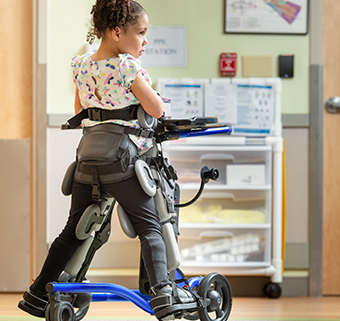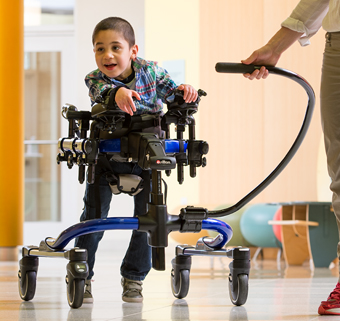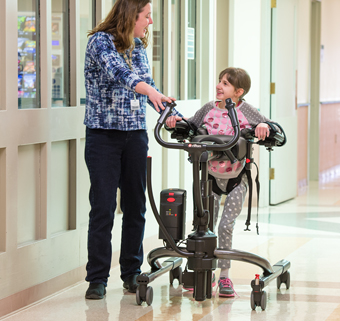
 The first part of our series looked at seating interventions for children with medical complexity. In this article we will focus on standing. Children with medical complexity (CMC) are defined as those who have high health care needs, one or more chronic conditions, and often require medical technology and significant environmental modifications (Cohen, 2011). Typically, children in this category function at level IV or V (CanChild) of the Gross Motor Functioning Classification System (GMFCS).
The first part of our series looked at seating interventions for children with medical complexity. In this article we will focus on standing. Children with medical complexity (CMC) are defined as those who have high health care needs, one or more chronic conditions, and often require medical technology and significant environmental modifications (Cohen, 2011). Typically, children in this category function at level IV or V (CanChild) of the Gross Motor Functioning Classification System (GMFCS).
Adaptive positioning for CMC: a review of the research
Standing is believed to have many benefits for children with multiple disabilities, including bowel control, bone density, tone control, range of motion, and pain control, among others (Damcott, et al., 2013). ; Capati, et al., 2020). As with most other interventions in this population, research on positioning is sometimes mixed. Studies can be small, it is difficult to find similar cohort groups, and results are not always consistent, making position decisions difficult. However, recent studies have been conducted that have shown favorable results in terms of hip abduction and standing. Martinsson and Himmelmann (2021) conducted a standing study for children with cerebral palsy (CP) who had GMFCS levels IV and V. They found that children who stood with 15-30° of hip abduction for ten hours per week had improved range of motion and lower hip migration percentages compared to those standing with 0-10° of abduction. This improvement was maintained for seven years in children with or without surgery who were in abduction. Gmelig Meyling et al. (2018) conducted a systematic review of the literature on hip migration and postural management in children with cerebral palsy. They found several articles that supported the idea that hip migration rates decreased while standing, but stated that there was a lack of sufficient evidence to make strong recommendations. Han et al. (2017) compared bone density in children with GMFCS level V and high tone to typically developing children. There were two groups of children in the standing group: those who stood for two hours a day for five days a week and those who stood for 20 minutes a day for two or three days a week and underwent physical therapy. The group that stood for two hours a day had an increasing trend toward better bone mineral density, while the group that stood for less time had a trend toward decreasing bone mineral density (the change was not significant for none of the groups). In terms of pain and contracture management, Capati et al. (2020) observed improvement in pain management, bowel management, and range of motion in a single 16-year-old subject (GMFCS level V) who completed a standing program for 15 months. What is very interesting about this article is that this subject had a 40° knee flexion contracture in one leg and bilateral hip flexion contractures and had not been standing for years. They used a knee and hip contracture system to position him upright.
Considerations for adaptive standing positioning
When implementing adaptive positioning interventions, there are a few things to keep in mind. There’s a great infographic on the SeekFreaks website which lists important considerations regarding orthopedic and pulmonary issues. A therapist must also consider the size of the classroom or room, the height of peers, and the activities the child will participate in, as well as other impairments such as decreased bone density or cardiopulmonary restrictions. In general, our group tends to avoid prone stands when students are taller or heavier and rely on for transfers, as these stands can make it difficult to load and unload students. We also encourage therapists to ask students and parents their preferences.

The Rifton Fighter
Rifton has multiple options for standing, including their new stand that switches from supine to prone and has many positioning features, including hip abduction up to 30°, the ability to stand at various angles, as well as individually adjustable legs (excellent). for a leg length discrepancy or differences in range of motion). Padded trunk and hip straps and sides are available to secure the student safely. Its large wheels and directional wheels allow for easy mobility so students can participate in standing activities with their peers. A stander like this would be great for multiple students or different activities for an individual student. According to the most recent research by Martinsson and Himmelmann (2021), the use of hip abduction can be helpful in improving range of motion and migration rate.

Rifton’s pacemaker
Because active movement may be more beneficial than static standing (Tornberg et al., 2020), options such as a Rifton Pacer gait trainer or the Rifton TRAM may be beneficial for students who have some level of mobility. GMFCS Level IV students are often able to walk short distances with an assistive device. Sometimes you may need a static position for an activity, and in these cases it may be beneficial for your student to use the walker with the wheels locked. Of course, in this case there should be an assistant next to the student. We have occasionally used a walker instead of a support for students who have GMFCS Level V when insurance or space limited our ability to obtain a support. But this option is probably only best for short periods of time and depends on the proximity of an assistant.

The Rifton Tram
The TRAM may also be useful for these students. Additionally, some students love movement and use their arms better than their legs, and for those students, mobile stands with large wheels can be a good option. These would also offer some cardiopulmonary benefit similar to the Pacer or TRAM.
It is important to offer functional activities while standing, including: participating in cooking activities, balloon volleyball, badminton, physical education activities, games of tag using technology such as a switch to participate with peers, whiteboard or smart board activities , arts and crafts activities, music or choral activities, and modified yoga or aerobic activities, to name a few. Again, consider your peers: if they are standing, your student may want to stand too.
Pain and comfort monitoring.
To measure activity tolerance and provide the best recommendations for standing time, a variety of pain scales should be used, including the Individualized Numerical Rating Scale (INRS) (Solodiuk and Curley, 2003) and the Face, Legs, Activity, Cry and Consolation (FLACC) scale (Merkel et al., 1997). A copy of these scales should be kept in areas where children/young adults are served to help staff identify painful behaviors and know when to stop or modify an activity based on these responses. Some children can also use a switch to alert staff and help them change positions. Also watch for skin color changes to identify cardiopulmonary fatigue. Using pulse oximeters and blood pressure monitors, especially when you begin standing or change the angle of standing, is an important way to monitor cardiopulmonary changes and tolerance. Also, remember to raise and lower students slowly to avoid sudden changes in tone, heart rate, and blood pressure.
Measure ongoing tolerance and create appropriate goals
Children and adolescents with medical complexity can make very small, but very functional changes, measured with SMART (specific, measurable, achievable, relevant, time-bound) or GAS (goal achievement scale) style goals using adapted equipment. Some of the gains will be at the caregiver’s level of assistance (i.e., the caregiver may be providing less support or assistance). Some ideas for goals using supports adapted from Rifton include:
Examples of SMART goals:
- With full postural support in the supine position at 75° tilt, the student will stand for 30 minutes in reading class with peers, without pain behavior as measured by the FLACC, on 75% of the tests observed.
- To improve school engagement, the student will stand for 60 minutes and participate in music class using an adaptive musical instrument with minimal assistance.
- While in stander for 60 minutes at home, the student will complete one weekly assignment with minimal to moderate help from family.
- While standing in physical education, the student will participate in activities with peers, receiving upper extremity assistance as needed, during one-hour intervals, three days per week.
GAS target example:
With full postural support in the supine position at 75° tilt, the student will stand for 60 minutes in an enrichment class with peers, with no pain behavior as measured by the FLACC.
|
Achievement level |
Score |
Description |
|
Base |
-2 |
With full postural support from the supine position at 75° tilt, the student will stand for 30 minutes in peer enrichment class, without pain behavior as measured by the FLACC. |
|
Less than expected result |
-1 |
45 minutes |
|
Expected expenses |
0 |
60 minutes |
|
Result greater than expected |
1 |
75 minutes |
|
Result much greater than expected |
2 |
90 minutes |
We hope this information has been helpful. Our next post will focus on walking and exercise to reduce sedentary behaviors in children and adults with medical complexity.







